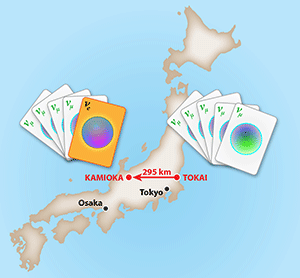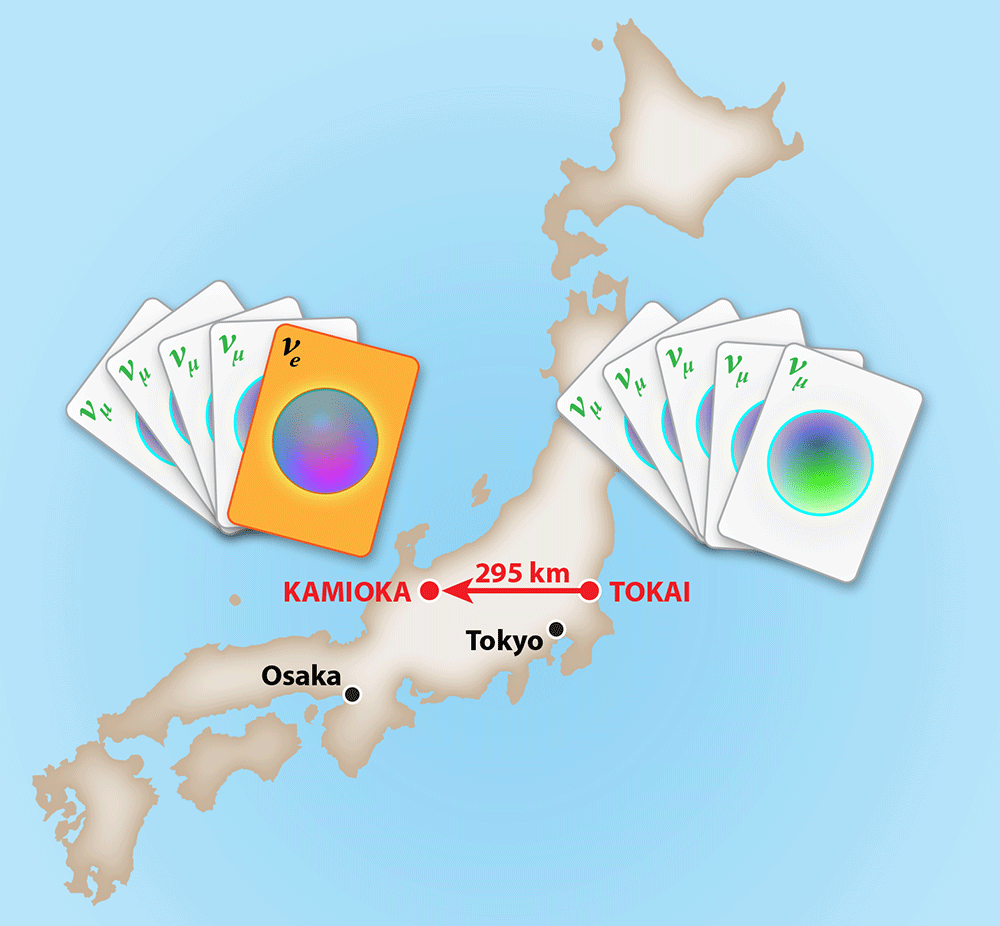Neutrino Experiments Come Closer to Seeing CP Violation
Charge-parity ( CP) violation—evidence that the laws of physics are different for particles and antiparticles—is often invoked as a “must” to explain why we observe more matter than antimatter in the universe. But the CP violation observed in interactions involving quarks is insufficient to explain this asymmetry. As a result, many theorists are looking toward leptons—and, specifically, neutrinos—for additional sources of CP violation. Researchers running the Tokai to Kamioka (T2K) experiment—a particle physics experiment at the Japan Proton Accelerator Research Complex (J-PARC)—have now made an important contribution toward the search for CP violation in neutrinos. Writing in Physical Review Letters, the T2K collaboration reports the strongest evidence to date for the appearance of electron neutrinos from a pure muon neutrino beam [1]. Their measurement allows them to determine a fundamental parameter of the standard model of particle physics, called θ13, which can in turn be used to make an early estimate of CP violation in neutrinos. Although this estimate has a large uncertainty, it will serve as a guide to future, more definitive neutrino experiments that are directly sensitive to CP violation.
Neutrinos come in three flavors: electron, muon, and tau. Each of these flavor states is known to be a mixture of the three allowed neutrino mass states, called m1, m2, and m3. This mixing is why one flavor state has a certain probability, over time, of transmuting, or “oscillating,” into another state. The oscillation rate depends, in part, on parameters called mixing angles and on the differences between the masses m1, m2, and m3.
T2K’s experiment is designed to gain information about one of these mixing angles, called θ13—named for where it sits in the so-called Pontecorvo-Maki-Nakagawa-Sakata (PMNS) matrix, a 3×3 matrix that describes neutrino oscillations. The collaboration performs what is called an “appearance” measurement. The experiment sends a beam of muon neutrinos over a long distance toward a detector that searches for the presence of electron neutrinos. Since the total number of electron neutrinos also depends on the propagation time of the initial state, T2K has to carefully select the initial state, energy, and distance traversed by the beam in order to extract θ13.
T2K’s measurement complements “disappearance” measurements, in which researchers look for a decrease in the flux of a particular neutrino state. Experiments using neutrinos produced in reactors fall into this later category. One advantage of an appearance experiment is that it is sensitive to other aspects of neutrino oscillations. In particular, appearance events depend on how the three neutrino mass states are ordered from lightest to heaviest (the “mass hierarchy”) and whether neutrinos respect the combined symmetry of charge and parity conjugation (the degree to which this process is violated is often referred to as the CP violating phase.) Both the mass hierarchy and the value of the CP violating phase are open questions in neutrino physics that have significant implications on our understanding of the standard model of particles.
T2K is the culmination of two impressive technological feats in particle physics (Fig. 1). On one end of the experiment, muon neutrinos are produced at the J-PARC beam facility in Tokai, Japan. Protons are accelerated and collided against a graphite target, producing copious quantities of unstable mesons (pions and kaons) that quickly decay and produce a shower of muon neutrinos with remarkably high purity. T2K works in what is known as an “off-axis” configuration, in which the axis of the primary beam of mesons is tilted a few degrees away from the detector. This configuration reduces unwanted background signals in the detector by narrowing the energy width and increasing the purity of the beam (specifically, it directs mesons with the appropriate sign and energy for producing muon neutrinos toward the detector).
The second half of the T2K experiment, the Super-Kamiokande (SK) detector, is located roughly 300km away, deep within the Kamioka mine. This immense 50 kiloton water Cherenkov detector was once used (and still is) to measure neutrino oscillations from the atmosphere—one of the first experiments to confirm that neutrinos could oscillate between flavor states, and hence possessed a finite mass [2] (see 1 September 1998 Focus). In its new role, the SK detector functions as the primary target for the Tokai neutrino beam. Instrumented with over 11,129 photomultiplier tubes, SK detects the faint Cherenkov light created by high-speed charged particles, which are produced when neutrinos interact with water molecules.
When a neutrino arrives in the detector, its weak state—meaning whether it’s an electron, muon, or tau neutrino—can only be identified by which lepton (electron, muon, or tau) is created in the neutrino interaction. So T2K’s primary challenge is to distinguish electrons from muons and other types of background. One source of background is the constant flux of cosmic rays hitting Earth. T2K therefore uses a pulsed beam of muon neutrinos, which allows them to distinguish the timing of the signal of interest (electron neutrinos from appearance events) from that of the cosmic rays. In addition, to characterize the neutrinos closer to the source, they make use of a much smaller detector located less than 1km from J-PARC. Compared to the SK detector, this “near” detector permits them to make a more precise measurement of the energy profile of the neutrino beam and the probability of neutrinos interacting with matter. Finally, they have developed a careful analysis of the topology of the Cherenkov light cone and the energy of each detector event that allows them to further delineate candidate signal events from background events. (The background is typically dominated by neutral pion decays.)
Over three years of data taking, during which T2K collided over 1020 protons to produce the muon beam, the researchers recorded 28 candidate electron-neutrino appearance events. Only 4.92±0.55 of these events are expected to be background, providing a clear observation of muon neutrinos transmuting to electron neutrinos with a statistical significance of over 7 sigma. (Put differently, there is less than one billionth of a percent chance that these events are from the background.) Earlier measurements from T2K [3] and the MINOS experiment that stretches between Illinois and Minnesota in the US [4] had also indicated a neutrino appearance signal over their respective backgrounds, though with a lower statistical significance.
The results from T2K contribute to a steady march toward a full understanding of neutrino oscillations. At face value, the measurement provides a complementary verification of the value of θ13 to that measured by reactor neutrino experiments [5] (see 23 April 2012 Viewpoint). In addition, T2K combines their measurement of θ13 with that measured from disappearance experiments and feeds its value into the equation describing muon neutrino to electron neutrino oscillations. This allows them to solve for possible values of the CP violation phase. T2K’s preliminary analysis of the phase, which can vary between - π and π, seems to disfavor certain nonzero values. (The precise excluded values depend on what they assume about the neutrino mass state hierarchy.) The uncertainty of the excluded values is, however, still too large to make a definitive statement about CP violation in neutrinos.
The true telltale sign of whether neutrinos exhibit CP violation will come from comparing appearance events for neutrinos and antineutrinos. Larger experiments are being planned to perform exactly this measurement. In many ways, the results from T2K are reminiscent of when measurements of solar neutrinos were used to tease out preliminary information about θ13 before definitive measurements from reactor experiments became available. A similar path seems to be emerging here, and it does not seem that it will be long before experimentalists determine if CP violation exists in neutrinos.
References
- K. Abe et al. (T2K Collaboration), “Observation of Electron Neutrino Appearance in a Muon Neutrino Beam,” Phys. Rev. Lett. 112, 061802 (2014)
- Y. Fukuda and et al., “Evidence for Oscillation of Atmospheric Neutrinos,” Phys. Rev. Lett. 81, 1562 (1998)
- K. Abe and et al., “Evidence of Electron Neutrino Appearance in a Muon Neutrino Beam,” Phys. Rev. D 88, 032002 (2013)
- P. Adamson and et al., “Electron Neutrino and Antineutrino Appearance in the Full MINOS Data Sample,” Phys. Rev. Lett. 110, 171801 (2013)
- F. P. An et al., “Observation of Electron-Antineutrino Disappearance at Daya Bay,” Phys. Rev. Lett. 108, 171803 (2012)





